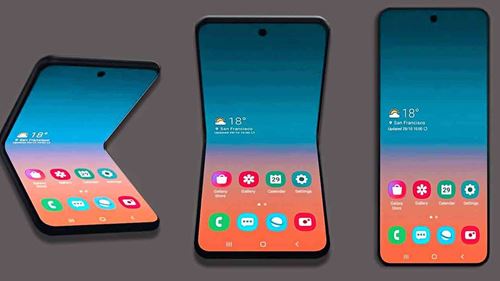Samsung Galaxy Fold 2 Samsung foldable phone
It first suffered from defects, but it finally arrived on the market a few months ago, becoming the most premium Samsung device currently on the market.
Conception
Judging from the recently unveiled photos featuring the so-called Galaxy Fold 2, the phone will have a flexible main screen with an Infinity-O cutout, surrounded by fairly thick glasses that make it look a bit cheap.
Unlike the Galaxy Fold, the clamshell suite has a very small cover screen to display key information such as time and notifications. A dual-camera configuration is located right next to the small screen.
Samsung appears to use the same hinge design used by the original model, but it is unclear whether any aspects have been changed to promote durability. The hinge appears to share its color with the rest of the case, and the phone could be launched in black, white and purple.
Overall, the Galaxy Fold 2 is intended to be a compact phone that can unfold to become twice as big. It doesn't quite follow the same philosophy as the original model, which was more focused on combining the phone and tablet form factors into one device.
Display
Samsung is working to eliminate the durability issues that plagued the original Galaxy Fold by improving the more durable flexible screen protector, which is based on ultra-thin tempered glass rather than polyimide.
However, it is unclear whether these new technologies will make their debut with the Galaxy Fold 2 clamshell, or the actual direct sequel to the original Fold, which is scheduled for release in the second half of 2020.
As far as the cover display is concerned, there is simply not a lot of information to pass along, but it is clear that this will not be the main selling point, as you can see in the image above.
It is related to practical uses and maybe even basic notification animations, but there is nothing exciting about it.
Cameras and other specifications
Camera configuration is just another area that could not be more different from one device to another.
While the Galaxy Fold, comes with no less than 6 cameras, the Galaxy Fold 2 clamshell, seems to be equipped with only three shooters, one of which is a selfie camera integrated in the Infinity-O display cutout.
The other two rear-facing sensors seem rather disappointing, especially since most Samsung smartphones now have at least two main cameras. The Galaxy Fold 2, however, is simply content with a few sensors, which means it should be missing a telephoto or ultra-wide lens.
The exact specifications of these sensors are unknown, but one could have a resolution of 108 MP, while the other could be a telephoto lens providing a 5x optical zoom, leaving the ultra-wide sensor out of the equation.
We are also fairly confident that the Galaxy Fold 2 will have a 900 mAh secondary battery, residing in one half. It will probably be used to power the small screen in the lid, while a larger secondary battery should power the more demanding flexible panel and other internal components.
Software Features
Judging from what we know so far, there is little custom software that the Galaxy Fold 2 clamshell will offer. There is simply no need for anything too sophisticated, and a 2.0 user interface coupled with Android 10 should be enough to provide a complete experience.
Find all the CES 2020 news on News Tech
The clamshell form factor will present a different software challenge for Samsung, in that applications would resize when the device is folded in half and if additional features could be enabled in that position.

































